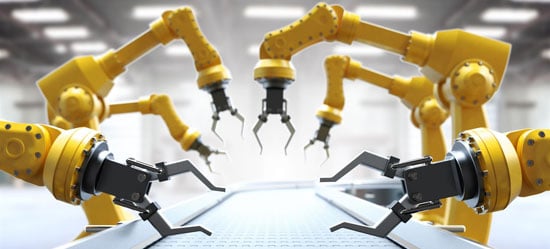
May 22, 2018
Blog Energy & Sustainability Smart Robotics in Manufacturing: More Human Than Machine?
Exciting innovations within the Internet of Things (IoT) are accelerating the market for the manufacturing of smart robotics to new heights, according to a recent webinar led by our senior editor Michael Sullivan. For example, Industry 4.0 initiatives such as simulation, cloud computing, augmented reality and cybersecurity are all playing a significant role in transforming industrial plants, processes and robots.
During the webinar, Sullivan placed emphasis on defining what elements make a machine intelligent. The conclusion? These up-and-coming robots are showing signs of autonomy—or the ability to work without human intervention—and can participate in collaboration with their robot counterparts.
“The robotic system can understand the construct from an expert, system driven model about what its working on and can therefore develop the next step of programs,” Sullivan said, during the webinar. “Moreover, this technology can adapt to its environment as it receives new challenges. It doesn’t require updated lines of code to be operational, but rather the system itself becomes adaptive.”
The global market for robotic manufacturing is anticipated to reach a value of $1.9 billion by 2022, indicating a compound annual growth rate (CAGR) of 15.8%. This increase is primarily attributed to more applications becoming available for robots, including engineering and materials usage, lower costs and miniaturized sensors, and advances in machine learning.
The technology that has contributed to these developments involves expert systems that provide data models, sensors that provide environmental signals and networks that provide feedback loops. By the end of the forecasted six-year period, the networks segment is expected to grow the most, being worth almost $800 million by 2022.
“Networking is key for the feedback loops within the sensor, but more importantly, machine learning needs a reference model. So, we introduced the concept of expert systems,” Sullivan said.
Webinar Highlights
“While robotics systems are quite common in manufacturing, many of them are inflexible as they have been designed for a perfect fit to the task,” said Sullivan within the corresponding report, Smart Robotics in Manufacturing: Global Markets to 2022. “However, due to advances in measurement science, processor miniaturization, sensor technology and cognitive technology, robotic systems can be made to be much more flexible in application. By implementing robotic systems with these advanced ‘smart’ capabilities, manufacturers can redesign processes and factory floors to accommodate a wide variety of product configurations and services.”

Electrical switches—devices that control the flow of electricity—are the backbon...

As the world accelerates toward net-zero emissions, hydrogen, and ammonia have e...

Hydrogen technology is widely used across industries like glass, fertilizer, met...

We are your trusted research partner, providing actionable insights and custom consulting across life sciences, advanced materials, and technology. Allow BCC Research to nurture your smartest business decisions today, tomorrow, and beyond.
Contact UsBCC Research provides objective, unbiased measurement and assessment of market opportunities with detailed market research reports. Our experienced industry analysts assess growth opportunities, market sizing, technologies, applications, supply chains and companies with the singular goal of helping you make informed business decisions, free of noise and hype.